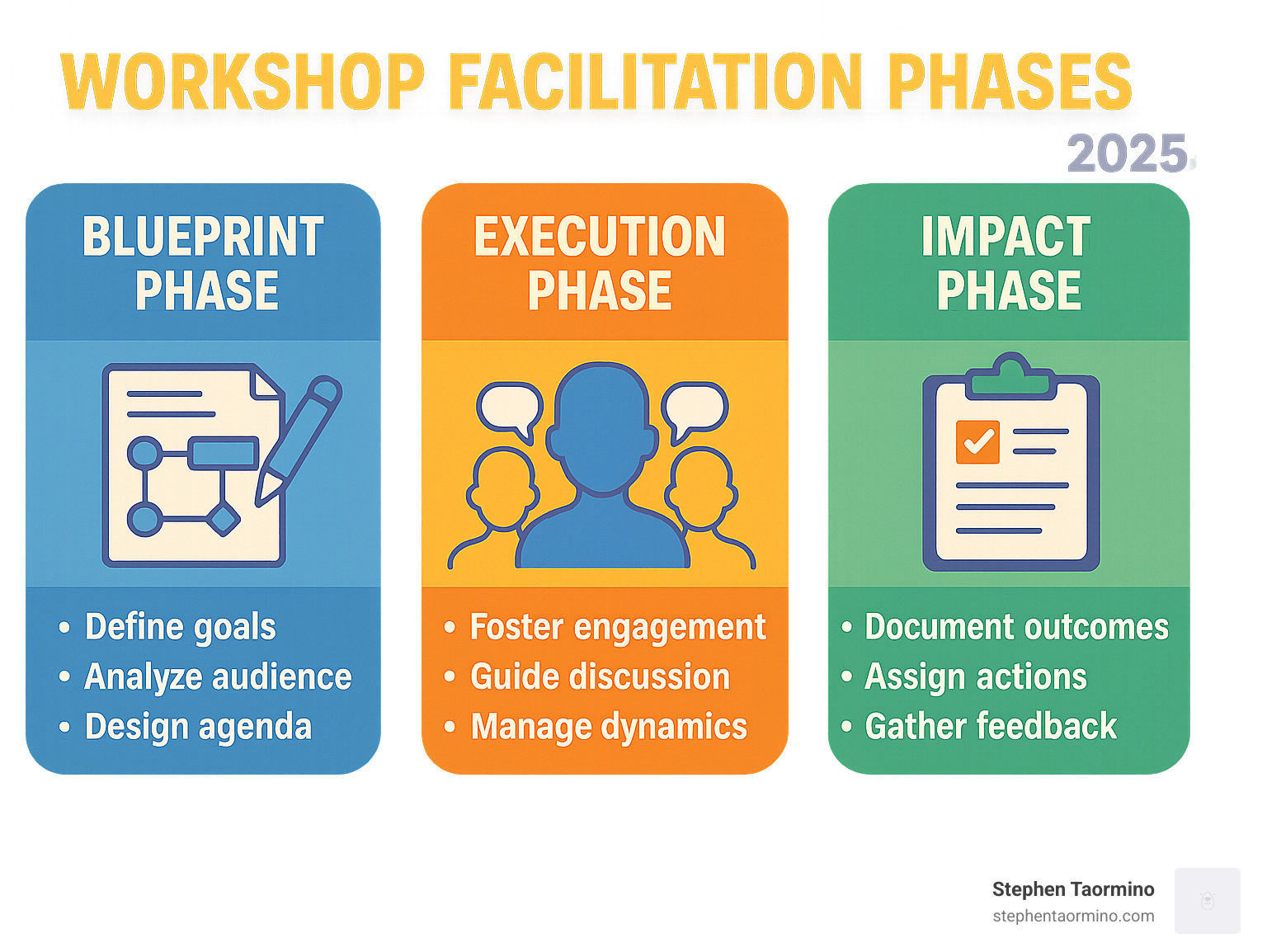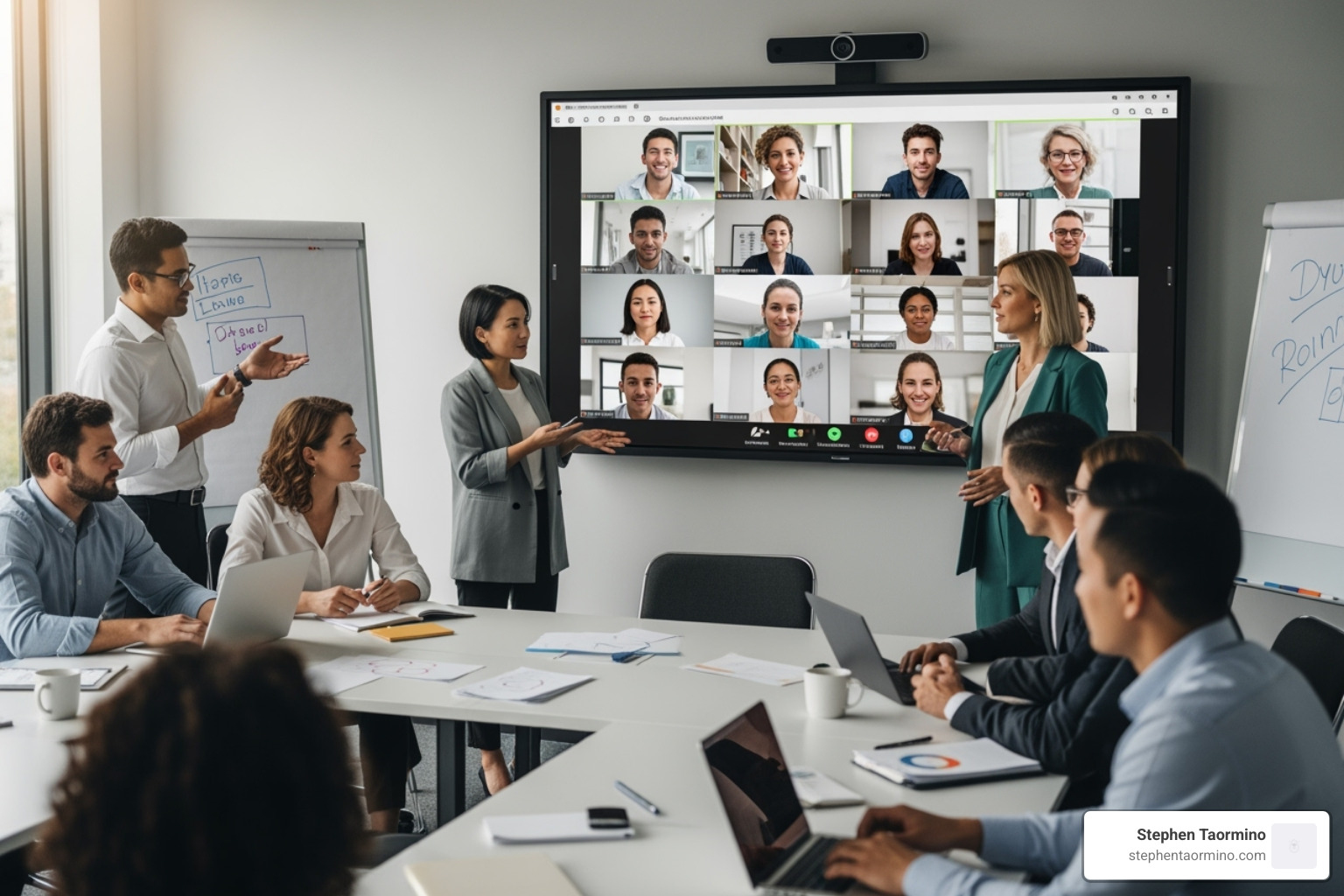How to Facilitate a Training Workshop: 3-Phase Master Plan
Why Effective Workshop Facilitation Transforms Teams and Drives Results
Learning how to facilitate a training workshop effectively can transform your team’s performance and drive meaningful organizational growth. The difference between a successful workshop and a forgettable meeting often comes down to one critical factor: facilitation. As Confucius wisely noted, “Tell me, and I will forget. Show me, and I may remember. Involve me, and I will understand.” Great facilitators involve people in their own learning journey.
Here’s the essential process:
Quick Guide to Facilitating a Training Workshop:
- Blueprint Phase (Before) – Define clear goals, analyze your audience, and design an engaging agenda.
- Execution Phase (During) – Create psychological safety, guide don’t control, ensure all voices are heard, and manage group energy.
- Impact Phase (After) – Document outcomes, assign clear next steps, gather feedback, and maintain follow-up engagement.

Most workshops fail because leaders confuse presenting with facilitating. They lecture instead of guide and control instead of enable. But when done right, facilitation open ups collective intelligence. It transforms a room of individuals into a cohesive team that can solve complex problems, generate breakthrough ideas, and commit to meaningful action.
I’m Steve Taormino, and over my 25+ years in leadership development, I’ve seen how mastering how to facilitate a training workshop can dramatically improve team performance. My approach combines marketing psychology with proven facilitation techniques to help leaders create workshops that don’t just inform—they transform.
The Foundations: Understanding the Facilitator’s Role
Before diving into the practical steps of how to facilitate a training workshop, it’s crucial to understand that facilitation is fundamentally different from teaching or presenting. A teacher instructs from the front, but a facilitator acts as a “guide on the side,” helping the group find its own path.
| Role | Primary Goal | Focus | Interaction Style |
|---|---|---|---|
| Facilitator | Enable group findy and decision-making | Process and participation | Guides from the side, asks questions |
| Teacher | Transfer knowledge and skills | Content delivery and comprehension | Instructs from the front, provides answers |
| Presenter | Share information and insights | Message delivery and engagement | Speaks to the audience, controls narrative |
Understanding this distinction is the key to creating workshops that produce lasting change.
What is Workshop Facilitation?
Workshop facilitation is the art of making group processes easier and more productive. The word “facilitate” literally means “to make easy.” As facilitators, we create the conditions for groups to think together, solve problems, and reach decisions they are committed to implementing. Our expertise lies in understanding how groups work best, not in having all the content answers. This approach is powerful in leadership development consulting because it honors the team’s existing knowledge and helps their collective wisdom emerge.
Core Principles and Goals of Effective Facilitation
Effective facilitation is built on four key goals: full participation, where every voice is heard; mutual understanding, ensuring everyone grasps not just what is said but why; inclusive decisions that the group can rally behind; and shared responsibility, where the team owns the outcomes because they helped create them.
To achieve these goals, we follow several principles: listen with curiosity, create an inviting and psychologically safe space, be authentic, and welcome improvisation. We also accept constructive conflict as a source of breakthrough thinking. A critical trap to avoid is the Curse of Knowledge—the assumption that participants share our background knowledge. We must always explain the bigger picture and use clear, jargon-free language.
Common Facilitation Myths to Avoid
Three myths often derail facilitators:
- The facilitator must be the hero. The goal isn’t to impress the group with your brilliance, but to guide them to their own solutions. The group should feel proud of what they accomplished.
- You must be an extrovert. Some of the best facilitators are introverts who excel at observation and thoughtful questioning. A solid process is more important than an outgoing personality.
- Facilitators must be subject matter experts. Trying to be both the content and process expert undermines objectivity. The team holds the content expertise; your job is to guide their thinking process.
Phase 1: The Blueprint for Success (Before the Workshop)
The success of any workshop hinges on thorough preparation. This “Blueprint Phase” is where we lay the groundwork to ensure every detail is considered. Being overprepared is always better than being underprepared.
Defining Your Purpose and Goals
First, define the workshop’s purpose by aligning with stakeholders on the “why.” What specific, measurable outcomes should participants achieve? Goals should be SMART—Specific, Measurable, Achievable, Relevant, and Time-bound. For example, instead of “brainstorm ideas,” aim for “generate and prioritize 5-7 actionable ideas for improving customer onboarding.” This clarity ensures everyone knows what success looks like.
Know Your Audience and Plan the Logistics
Understanding your audience is essential. Analyze their group dynamics, knowledge levels, and expectations. For ideal interaction, aim for around 7 participants per facilitator, though groups of 8-12 are also effective. The room setup should encourage interaction, and the environment should feel welcoming. Prepare your materials checklist (sticky notes, markers, whiteboards) and test any virtual tools (digital whiteboards, breakout rooms) in advance. This preparation shows respect for participants’ time and contributes to their professional development.
Designing a Powerful Agenda
The agenda is your workshop’s roadmap. A powerful agenda balances energy levels and engagement by:
- Sequencing activities: Alternate between active and passive sessions, and mix individual, pair, and group work. Break up lectures into 5-10 minute segments.
- Managing time: Be realistic with timings. The average person can maintain focus for about 3-4 hours on challenging tasks. Announce time limits for exercises.
- Building in breaks: Schedule breaks every 90-120 minutes to help participants recharge.
- Using icebreakers: Use activities like Two Truths and a Lie or Human Bingo to build trust and energy.
- Having a Plan B: Always prepare backup activities in case something takes more or less time than expected, or if a tool fails. A well-designed agenda is structured yet flexible.
Phase 2: How to Facilitate a Training Workshop in Real-Time (During the Session)
This is the execution phase, where planning shifts to dynamic guidance. Your role is to conduct the orchestra, helping everyone create something great together.

Creating a Safe and Inclusive Learning Environment
Psychological safety is essential for learning. Start with a warm welcome, share the agenda, and establish “Community Agreements” with the group to create shared ownership of the rules. Use simple check-ins to gauge the room’s energy and give everyone a voice from the start. Normalize the discomfort that comes with growth by explaining that you’re aiming for the “challenge zone,” not the “panic zone.” Finally, address basic needs first—per Maslow’s hierarchy, people can’t focus on high-level thinking if they are uncomfortable. Building trust happens through these small, authentic actions.
Key Steps for How to Facilitate a Training Workshop
Your actions in the moment determine the workshop’s success. Here are the key steps:
- Set expectations: Walk through the agenda so participants know what’s coming.
- Facilitate, don’t control: Resist the urge to have all the answers. Guide with open-ended questions like, “What would need to be true for this to succeed?” instead of “Do you think this will work?”
- Summarize regularly: Reflect back what you’re hearing to ensure shared understanding and create “aha” moments.
- Ensure all voices are heard: Use structured go-arounds or gently invite quieter participants to share their thoughts.
- Use visual aids: Make ideas concrete with sticky notes, whiteboards, or digital tools to aid memory and collaboration.
- Manage time flexibly: Communicate time limits but be willing to adapt if an important conversation emerges, much like a skilled conference moderator adjusts to a live discussion.
Managing Engagement and Energy
Energy management is a critical, yet underrated, facilitation skill. You must constantly read the room by observing body language and participation levels. When energy dips, use short energizers or strategic brain breaks to reset focus. Our brains need a reset after about 20-30 minutes of intense focus.
Keep participants engaged by varying activity types, mixing individual reflection, paired conversations, and group work to appeal to different learning styles. A powerful framework is the “Diverge and Converge” technique: first, generate many ideas without judgment (diverge), then organize and prioritize them (converge). This structure balances creative exploration with focused decision-making, keeping the group on track toward its goals.
Phase 3: Ensuring Lasting Impact (After the Workshop)
A workshop is only successful if it leads to real-world action. The “Impact Phase” ensures the learning sticks and translates into measurable results.
Documenting Outcomes and Communicating Next Steps
To translate workshop energy into change, clear documentation is key. Capture artifacts like whiteboard photos or digital boards. Summarize the key decisions and insights generated. Most importantly, work with the group to create a clear action plan that specifies who will do what by when. This fosters shared responsibility. After the workshop, communicate these outcomes and reiterate how each task contributes to the larger organizational goals, ensuring everyone sees the big picture.
Gathering Feedback and Driving Continuous Improvement
Feedback is a gift for continuous improvement. Ask for it after participants have had time to apply the learnings, as this provides a more accurate measure of impact. Use simple evaluation forms or a “more/less/same” activity to gather input on the content, pace, and facilitation. Also, conduct a facilitator self-debrief immediately after the session to reflect on what went well and what could be improved. This process ensures that workshop outcomes lead to tangible next steps, contributing to effective executive leadership training.
Advanced Facilitation: Handling Challenges and Hybrid Environments
Great facilitators shine when things don’t go as planned. Your ability to adapt while focusing on how to facilitate a training workshop effectively is what separates good from great. View challenges not as problems, but as opportunities to demonstrate your skill.
Managing Conflict and Difficult Participants
Challenging behavior is often a sign that a participant’s needs aren’t being met. Identify patterns like over-talking or disengagement and intervene constructively. For an over-talker, you might say, “Thank you for that insight. Let’s hear from someone who hasn’t shared yet.” For under-participants, use paired exercises to create a safer space to contribute.
Conflict isn’t the enemy; productive disagreement can lead to breakthroughs. When tensions rise, reframe the conflict by saying, “It sounds like we have two important perspectives here; let’s explore both.” Your role is to stay neutral and mediate, helping the group find common ground. Most importantly, don’t take it personally. Stay focused on guiding the process.
Advanced Tips for How to Facilitate a Training Workshop Remotely
Remote and hybrid workshops require a different approach to facilitation.

- Choose the right tools: Use digital whiteboards like Miro or Mural and video platforms with reliable breakout rooms. The technology should support, not hinder, collaboration.
- Use breakout rooms strategically: Use them frequently for small group discussions, problem-solving, and peer learning to encourage participation.
- Set clear remote ground rules: Establish expectations around muting, using chat, and camera use to create structure and psychological safety.
- Combat virtual fatigue: Build in more frequent, shorter breaks. Vary activities rapidly with polls, chats, and interactive exercises. Avoid lecturing for more than 10 minutes straight.
- Plan for technical difficulties: Have backup plans and stay calm when glitches occur. Your composure sets the tone for the group.
Mastering remote facilitation makes you a more versatile facilitator overall, similar to the skills needed to be an effective webinar host.
Frequently Asked Questions about Facilitating a Training Workshop
What is the single most important skill for a workshop facilitator?
The most critical skill is active listening combined with adaptability. Active listening involves tuning into the group’s energy and unspoken concerns. Adaptability is the ability to pivot your approach based on what you’re observing. This combination allows you to move beyond a rigid script and facilitate a dynamic experience that truly meets the group’s needs.
How do you ensure a workshop’s outcomes are actually used?
Lasting impact comes from intentional follow-through. During the workshop, create a clear action plan with specific names and deadlines to foster shared ownership. After the workshop, maintain momentum with follow-up engagement, such as sending visual summaries or scheduling check-ins. Finally, ask for feedback on the workshop’s effectiveness only after people have had time to implement the outcomes, as real impact takes time to reveal itself.
What’s the ideal number of participants for a training workshop?
The ideal number depends on your goals. For deep, interactive sessions, 7 participants per facilitator is the sweet spot. For lively group dynamics, 8-12 participants works beautifully. For broader knowledge-sharing, you can successfully manage 15-20 people with strong processes for small group breakouts. The key isn’t the exact headcount, but designing activities that allow everyone to contribute meaningfully.
Conclusion
Mastering how to facilitate a training workshop is about changing how teams collaborate and achieve results. We’ve walked through the three essential phases that turn ordinary meetings into catalysts for change.
- The Blueprint Phase is about laying the groundwork for success through clear goals and thoughtful design.
- The Execution Phase is where you guide the group to open up its collective intelligence in a psychologically safe environment.
- The Impact Phase ensures that insights become actions and that momentum is sustained long after the workshop ends.
Effective facilitation shifts the dynamic from passive listening to active co-creation, where everyone contributes and owns the results. It’s about guiding participants to become the heroes of their own journey.
At Stephen Taormino, this approach reflects my philosophy on leadership and human connection. By combining marketing psychology with proven facilitation techniques, I help leaders build confidence, foster stronger relationships, and develop impactful teams. We create spaces where organizations can solve complex problems and drive real business growth.
Your role as a facilitator is to be the guide on the side, creating the conditions for others to do their best thinking together. When you do this well, you don’t just run a workshop—you build a stronger, more capable team.
Ready to transform your team’s performance through collaboration? Explore our expert-led workshops to lift your team’s performance and find how strategic facilitation can become your competitive advantage.

